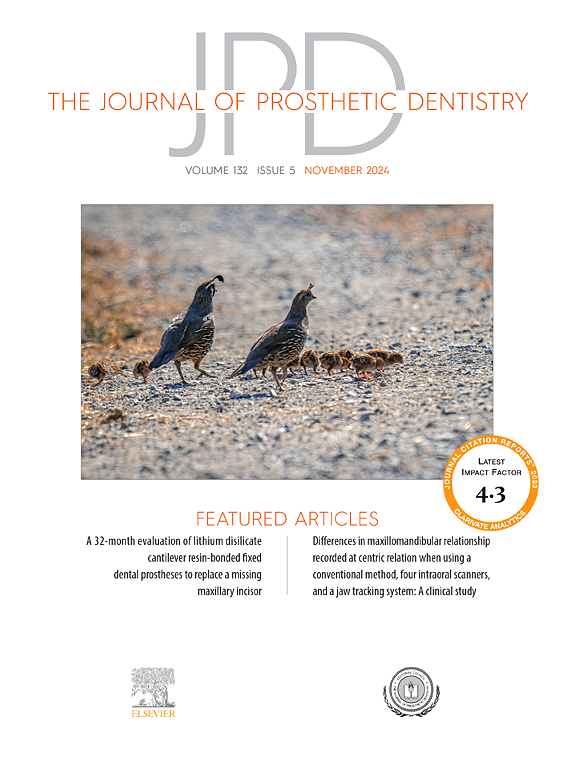In vitro comparison between complete arch abutment-level implant impressions with photogrammetry, grammetry, and intraoral scanning
IF 4.8
2区 医学
Q1 DENTISTRY, ORAL SURGERY & MEDICINE
引用次数: 0
Abstract
Statement of problem
Photogrammetry (PG) has emerged as a promising recording technique for fabricating implant-supported prostheses. However, the existing evidence on the accuracy of dental PG devices is still limited.
Purpose
The purpose of this in vitro study was to evaluate the trueness and precision of a newly introduced advanced PG device (MicronMapper; SIN 360) by comparing it with grammetry and intraoral scanning.
Material and methods
Four implants (BioHorizons) were placed in an edentulous mandibular model. Multi-unit abutments (BioHorizons) were positioned and tightened to 30 Ncm. A digital reference cast (Control group) was obtained by scanning the model with a laboratory scanner (inEosX5; Dentsply Sirona). Three test groups were evaluated: PS (Primescan), PS-OS (Primescan and OptiSplint), and PG (MicronMapper; SIN 360). Test files were superimposed with the reference file (trueness) and pairwise within groups (precision) using a 3D evaluation software program (Geomagic Control X). Root mean square (RMS) values were calculated. Analysis of variance (ANOVA) was used to analyze differences in RMS values among groups (α=.05), followed by the Tukey post hoc test.
Results
For trueness, group PG showed the lowest mean ±standard deviation RMS values (20.5 ±0.6 µm), followed by PS-OS (30.9 ±16.8 µm) and PS (56 ±0.7 µm). A statistically significant difference was found between groups PG and PS (P<.001), as well as PS-OS and PS (P=.004). For precision, the lowest RMS values were detected in group PG (6 ±1.2 µm), followed by PS (9.5 ±3.3 µm) and PS-OS (23.3 ±22.3 µm). No statistically significant differences were detected among the test groups in terms of precision (P=.192).
Conclusions
Photogrammetry obtained the best accuracy. Grammetry improves the trueness; however, it appears to have no positive impact on the precision of complete arch implant recordings.
全弓基台水平种植体印模与摄影测量、测量和口内扫描的体外比较。
问题说明:摄影测量(PG)已成为一种有前途的记录技术,用于制造种植体支持的假体。然而,现有的证据表明牙科PG装置的准确性仍然有限。目的:本体外研究的目的是评估新引入的先进PG设备(MicronMapper;并与测量法和口内扫描进行比较。材料与方法:将4个种植体(BioHorizons)植入无牙下颌模型。定位多单元基台(BioHorizons)并拧紧至30 Ncm。用实验室扫描仪(inEosX5;Dentsply Sirona)。评估三个试验组:PS (Primescan)、PS- os (Primescan和OptiSplint)和PG (MicronMapper);罪360)。使用三维评估软件(Geomagic Control X)将测试文件与参考文件(真实度)叠加,并在组内成对(精度)。计算均方根(RMS)值。采用方差分析(ANOVA)分析组间RMS值差异(α= 0.05),并进行Tukey事后检验。结果:正确率PG组平均±标准差RMS值最低(20.5±0.6µm), PS- os组次之(30.9±16.8µm), PS组次之(56±0.7µm)。PG组与PS组之间的差异有统计学意义(p)。结论:摄影测量获得了最好的准确度。测量提高了准确性;然而,它似乎对全弓种植体记录的精度没有积极的影响。
本文章由计算机程序翻译,如有差异,请以英文原文为准。
求助全文
约1分钟内获得全文
求助全文
来源期刊

Journal of Prosthetic Dentistry
医学-牙科与口腔外科
CiteScore
7.00
自引率
13.00%
发文量
599
审稿时长
69 days
期刊介绍:
The Journal of Prosthetic Dentistry is the leading professional journal devoted exclusively to prosthetic and restorative dentistry. The Journal is the official publication for 24 leading U.S. international prosthodontic organizations. The monthly publication features timely, original peer-reviewed articles on the newest techniques, dental materials, and research findings. The Journal serves prosthodontists and dentists in advanced practice, and features color photos that illustrate many step-by-step procedures. The Journal of Prosthetic Dentistry is included in Index Medicus and CINAHL.
 求助内容:
求助内容: 应助结果提醒方式:
应助结果提醒方式:


